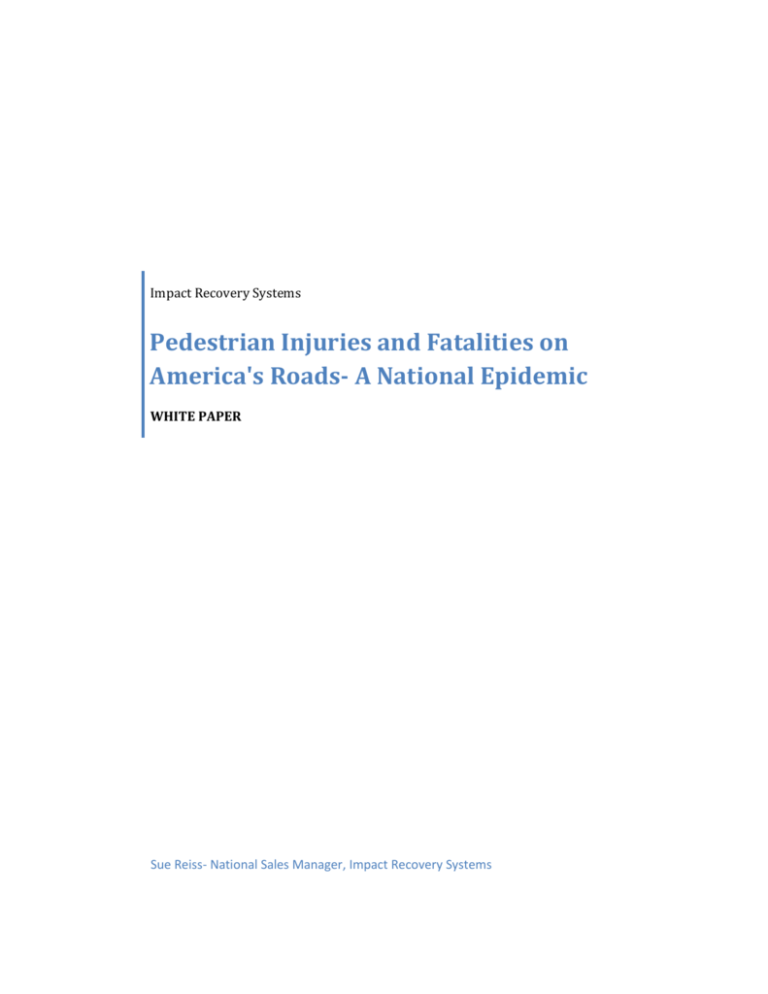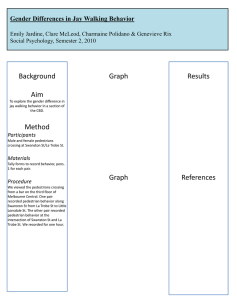Pedestrian Injuries and Fatalities on America`s
advertisement

Impact Recovery Systems Pedestrian Injuries and Fatalities on America's Roads- A National Epidemic WHITE PAPER Sue Reiss- National Sales Manager, Impact Recovery Systems Executive Summary Many studies have been conducted for over a decade on effective low cost engineering treatments used to improve the safety of pedestrian road users in marked and unmarked crosswalks on busy arterial streets. Motorist yielding data from various treatments provides statistically significant evidence of the effectiveness of those treatments collected from different regions of the country, varying road widths, as well as a variety of traffic and pedestrian volumes. Many of the early studies look specifically at the use and effectiveness of Centerline Pedestrian Signs to increase conspicuity at unmarked intersections. Other research addresses the use of red signal or beacon, “active when present” devices and other enhanced and/or high visibility treatments, including midblock signals and half signals. There is a disparity in available funding for vehicular road users and their facilities vs. other more vulnerable segments of the population who share those roads. There are many low cost options that engineers can include in their toolboxes to help address these safety concerns. Staggering Statistics Our nation’s roadways are a mortal threat to a very vulnerable segment of road users – pedestrians. Statistics show that 5,000 pedestrians are killed annually, while 64,000 are injured in accidents involving motor vehicles. NHTSA’s most recent statistics, for 2009, reflect a trove of gloomy, if enlightening statistics that reflect pedestrian fatalities represented 12.1% of the people killed in traffic crashes for that year. The National Highway Traffic Association and the Insurance Institute report that 11% of motor vehicle fatalities involve pedestrians, and that pedestrian death is second only to occupant death in terms of motor vehicle fatalities. Every 8 minutes, on average, a pedestrian is hurt in a traffic accident, and shockingly, every 2 hours, on average, a pedestrian’s life is lost in traffic. A pedestrian has an 85% chance of death when involved in a motor vehicle collision at 40 mph, a 45% chance of death at 30 mph and a 5% chance of death at 20 mph. Young children and the elderly are the most vulnerable for pedestrian accident related injuries. Based on population, children under the age of 16 are most likely to be struck by a motor vehicle. Elderly pedestrians, although struck less frequently than children, are more likely to die after being struck. This group accounts for 16% of all pedestrian fatalities and 6% of all pedestrian injuries. Lack of Funding Dangerous By Design indicated in their report, Solving the Epidemic of Preventable Pedestrian Deaths ranked the 10 most dangerous metropolitan areas for pedestrians in 2007-2008, were Orlando, Tampa, Miami and Jacksonville, Florida; Memphis, Tennessee; Raleigh, North Carolina; Louisville, Kentucky; Houston, Texas; Birmingham, Alabama and Atlanta, Georgia. The three safest cities were Seattle, Washington; Portland, Oregon and Minneapolis-St. Paul, Minnesota. The report compiled the list after gathering data from all 360 metropolitan areas in the United States. The authors complained that states aren’t spending enough to make roads safer for people who are on foot, on a bike or in a wheelchair. The report finds wide disparities in the amount each state spends. For example, Providence, Rhode Island spends $4.01 per person to increase pedestrian and cyclist safety, while Orlando, the city with the worst statistics, spends 87 cents. Incredibly, in spite of the pedestrian death rate (12%) as a percentage of the total traffic fatalities statistic, only 1.5% of transportation funding is allocated to addressing pedestrian safety issues. The field of traffic engineering has traditionally focused on the operations of motorized modes of transportation. While that focus is the most common, many engineering projects today are also including accommodations for non-motorized road users. All across the United States, cities and even smaller towns are drafting master plans that incorporate pedestrian and bicycle networks, including both non-motorized paths and trails and facilities shared with motorized traffic. This growing focus on pedestrian and bicycle facilities demands that proper methods of analysis are developed to evaluate the safety of pedestrians, bicyclists and other non-motorized modes as well as their interaction with vehicular traffic. Early Studies The sobering statistics cited above are not new; in fact, solutions to the pedestrian injury/fatality crisis in the United States have been studied for years. One of the earliest studies, dated in August of 1997, which was conducted by the City of Madison Department of Transportation, evaluated the use of Yield to Pedestrian Signs placed at centerline, in improving the safety of pedestrians in unsignalized intersections. Their study looked at the behavior of motorists when centerline pedestrian signs were added to several pedestrian-friendly areas of their city. The measure of effectiveness used was the occurrence of motorists yielding for pedestrians who were using the crosswalks. This study was very forward-looking, since there was no provision in the Federal Manual at that time, which allowed the use of such signs, placed at centerline. The City of Madison requested and received approval from the Federal Highway Administration to experiment with regulatory in-street “Yield to Pedestrian” signs at selected marked crosswalk locations. The observations collected showed that the occurrence of motorists yielding to pedestrians increased significantly at sites studied. The signs were constructed of high impact plastic with high intensity sheeting, and were mounted in the street on flexible post assemblies which were designed to fold down upon impact and then right themselves and reorient to traffic afterwards. The assembly was secured to the pavement with epoxy and bolts so that the device would not be launched if struck by an errant vehicle. The desired effect of these signs was to increase driver compliance with Wisconsin’s pedestrian rights laws. Madison used a “before and after” experimental method at each test site with the installation of the YTP sign as the primary treatment. To avoid bias, the same observation method, observation points and observation times were used during both the “before” and “after” observation periods. Data was only collected during good weather and in the absence of atypical traffic conditions. Video recording equipment was used as a tool to enable the two member survey crew to accurately and consistently evaluate whether or not the criteria was met. At the time of Madison’s study, neither these signs, nor their location in the street, were contained in the federal Manual on Uniform Traffic Control Devices. Wisconsin Statutes required that “all traffic control devices placed and maintained by local authorities SHALL conform to the Manual” The City of Madison’s report was one of the reference studies that FHWA used in its evaluation of and inclusion of such a sign in the 2003 MUTCD. Since that early study, many others have been conducted, including Cedar Rapids, Iowa (May, 2003), Transportation Research Board (January, 2006), ITE (April, 2004), culminating in an in-depth 322 page study conducted most recently by PennDOT, through the North Carolina State University in 2008. The Cedar Rapids Study incorporated findings from not only the Madison Study, but also studies conducted in the State of New York, Nova Scotia, Canada, Portland, Oregon, as well as Michigan State University. Overall, this consolidated study found a statistically significant increase in the percent of vehicles stopping for pedestrians following low cost crosswalk enhancements, an increase from 62% to 81% overall. Some studies, including the Nova Scotia study, resulted in even more statistically significant and unexpected differences, with drivers stopping 6 meters (or more) in advance of the crosswalk following the installation of the signs increasing from an impressive 13% to 54%. Those stopping 3 meters (or more) increased from 37% to 83%. Contributions of Impact Recovery Systems In recognition of the importance of addressing pedestrian safety in the next decade, the American Traffic Safety Services Association awarded Impact Recovery Systems their prestigious Innovation of the Year Award for 2010 at its annual Expo in San Antonio, Texas. The Omniped®/Solestrian® Pedestrian Messaging Center that was developed by IRS, was directed at increasing the conspicuity of Centerline Pedestrian Signs when installed at unsignalized intersections. The Innovation of the Year Award was an acknowledgement of the need to relay messages to distracted pedestrians, as well as the traditional messages conveyed to the motorist, alerting each to the presence of the other. The solar-powered Solestrian version of the Pedestrian Messaging Center added illumination of the sign in lowlight areas in an effort to increase the conspicuity of the crosswalk. Importance of Centerline Pedestrian Signs Whether using the standard Centerline Pedestrian Sign or the more recently developed Innovation of the Year sign, scores of studies have substantiated the improvement in pedestrian safety that can be realized by using this type of low-cost solution to alter motorist behavior toward the vulnerable pedestrian road user, as shown in Image 1. Image 1: example of a pedestrian safety installation, alerting drivers of the upcoming crosswalk. Additional Treatment Options Centerline pedestrian signs were not the only treatment options evaluated in the cited studies. The Transportation Research Board’s Study looked at three different intersection treatments, as shown in Figures 1 and 2. In addition to the enhanced and/or high visibility treatments studied by Madison and Cedar Rapids, TRB also evaluated red signal or beacon devices and “active when present” devices. They cite in their study another national study which was initiated in an effort to improve safety for pedestrians crossing heavily-traveled roadways at unsignalized intersections. That Study, titled “Improving Pedestrian Safety at Unsignalized Roadway Crossings”, was jointly funded by the Transit Cooperative Research Program (TCRP) and the National Cooperative Highway Research Program (NCHRP) with the project designations TCRP D-08 and NCHRP 3-71. The Study had two main objectives: 1. Recommend selected engineering treatments to improve safety for pedestrians crossing highvolume, high speed roadways at unsignalized intersections, in particular those served by public transportation; and 2. Recommend modifications to the Manual on Uniform Traffic Control Devices pedestrian traffic signal warrant. Their findings indicated that the red signal or beacon devices were the most effective, with yielding rates above 94% for all study sites. Most of the treatments in the other two categories had statistically similar motorist yielding levels. Pedestrian Crossing Flags were effective in achieving 65% compliance, while Centerline Pedestrian Signs demonstrated 87% compliance. Because of the wide range in measured compliance rates between sites, the research team hypothesized that there were other variables that were influencing treatment effectiveness. For example, an in-street pedestrian crossing sign installed on a wide, high-speed arterial would likely produce a lower compliance rate than if installed on a narrow, lower-speed collector street. This finding agreed with the Cedar Rapids Study, since those researchers concluded that the “State Law – Yield to Pedestrian” sign has had a positive impact on driver behavior, although the effect is not dramatic in ALL applications. Figure 1: Summary of Motorists Yielding at Innovative Pedestrian Crossing Treatments (Turner, Fitzpatrick, Brewer and Park) Figure 2: Summary of Motorist Yielding Compliance from Three Sources (Turner, Fitzpatrick, Brewer and Park) Because the red signal or beacon treatments consistently performed well, the research team concluded that these treatments were effective because they send a clear regulatory message (a red signal means “stop”) to motorists that they must stop for pedestrians. The authors therefore recommended the adoption of red signal or beacon devices (e.g. midblock signals, half signals (HAWK)) into the engineer’s toolbox to improve pedestrian crossing safety along busy arterial streets. Crosswalk Improvements In April of 2004, the U.S. Department of Transportation, in conjunction with ITE, produced a brief addressing pedestrian safety at intersections. They cited that roadways need to be designed to accommodate the needs of all road users. They indicated that many pedestrians, especially in large urban areas, violate pedestrian traffic control and place themselves at risk for collisions with motor vehicles. Their brief recommended crosswalk improvements such as a ladder or cross-hatched pattern pavement markings more visible to motorists, the use of pedestrian crossing warning signs, moving the “stop line” further back from crosswalk, installing raised crosswalks, and/or the use of in-pavement lights to alert motorists to the presence of a pedestrian crossing. Their brief also detailed pedestrian safety countermeasures proven to be effective in increasing conspicuity of intersections (especially unsignalized intersections). Among those countermeasures was the recommendation for the use of MUTCD Sign R1-6 STOP FOR PEDESTRIANS or YIELD TO PEDESTRIAN signs to be placed at crosswalks without signals in central business districts and other areas of high pedestrian activity to reinforce and remind drivers of the laws regarding the right-of-way of pedestrians. Finally, the ITE report recommended intersection design and physical improvements that included the installation of barriers such as fences or shrubs to discourage pedestrians from crossing at unsafe locations, the use of bulb-outs at intersections to reduce pedestrian crossing distances, a provision for wide refuge islands and medians, the construction of pedestrian overpasses and underpasses, the installation of raised medians and the reduction of corner radii. Intersection operations should incorporate the reassessment of signal operations including the consideration of pedestrian walking speeds, illumination, mid-block traffic signal installations and far-side bus stops. Dangerous by Design expanded crosswalk improvement suggestions by recommending the use of traffic calming techniques such as reconfiguring road alignments and installing barriers like roundabouts to slow drivers, making streets more accessible. They were also in favor of expanding the Safe Routes to School program, which installs or improves crosswalks, signals and other features and would make walking and biking safer to children. They went on to indicate that more cities are adopting so-called complete streets policies that give all modes of transportation, from walking to driving to riding the bus, equal access and the same priority. End Results The application of many low cost solutions has been widely utilized by a variety of states in alerting motorists to the presence of pedestrians, and their inclusion in the 2003 MUTCD adds the endorsement of the FHWA to their potential use in effecting a reduction in the incidence of pedestrian injuries and fatalities. In response, a number of manufacturers have developed signs compliant with the Manual to aid in this effort, among them, Impact Recovery Systems in San Antonio, Texas, a supplier of some of the units utilized in the earlier and more current studies. In 1996, the ITE Journal released a report entitled Special Signs and Pavement Markings Improve Pedestrian Safety. That report referenced research that had been conducted at intersections with traffic signals, but indicated that relatively inexpensive signs and markings could be installed at pedestrian crossing locations without signals. The signs and markings used in their study were relatively inexpensive and could be widely applied by traffic engineers where conflicts between pedestrians and turning vehicles are a problem. In spite of the plethora of studies performed over the last 15 years, Dangerous by Design released a report in November of 2009 entitled Solving the Epidemic of Preventable Pedestrian Deaths (and Making Good Neighborhoods). That report indicated “Too many transportation agencies have focused their investments on serving vehicles that result in unsafe, unhealthy environments for walking and bicycling. It’s time recipients of federal taxpayers’ money were held accountable for addressing this epidemic of preventable deaths”, according to Ann Canby, president of the Surface Transportation Policy Partnership. It is time. About Impact Recovery Systems Impact Recovery Systems®, Inc. has been the manufacturer if flexible, high impact traffic devices for road and pedestrian safety since 1991. Available for both temporary and permanent usage, applications include highways, work zones, train platforms, parking lots and pedestrian areas. Award winning for product innovation, Impact Recovery Systems’ products meet MUTCD standards and are NCHRP-350 approved. For more information: www.impactrecovery.com, 800.0736.5256, info@impactrecovery.com REFERENCES 1. Fitzpatrick, K. et al Improving Pedestrian Safety at Unsignalized Roadway Crossings, DRAFT Project Report, Transit Cooperative Research Program, August 2005 2. Lalani, N. and the ITE Pedestrian and Bicycle Task Force, Alternative Treatments for At-Grade Pedestrian Crossings, Publication FHWA-RD-01-142, FHWA U.S. Department of Transportation, May 2001 3. Zegeer, C.V. J.R. Stewart, H.H. Huang, and P.A. Lagerwey, Safety Effects of Marked Vs. Unmarked Crosswalks at Uncontrolled Locations: Executive Summary and Recommended Guidelines. Publication FHWA-RD-01-075, FHWA, U.S. Department of Transportation, March 2002 4. Kannel, Edward J., Reginald R. Souleyrette, Ryan Tenges, In-Street Yield to Pedestrian Sign Application in Cedar Rapids, Iowa, CTRE Project 02-115, May 2003 5. Huang, Herman, Charles Zegeer, Richard Nassi and Barry Fairfax, The Effects of Innovative Pedestrian Signs at Unsignalized Locations, Highway Safety Research Center, University of North Carolina, Chapel Hill, North Carolina 1996 6. Hunter, William W., Jane C. Stutts, Wayne E. Pein and Chante L. Cox, Pedestrian and Bicycle Crash Types of the Early 1990’s. Report No. FHWA-RD-95-163, FHWA, McLean, Virginia, June, 1996 7. Madison, Wisconsin, 2000, Field Evaluation of Experimental Yield to Pedestrian Signs. Available at http://walkinginfo.org/rd/devices.htm. 8. “Crosswalk Safety Problem”, Public Works, Vol. 134, No. 2, February 2003 pp. 34-35 9. Van Houten, Ron, Dave McCusker, Sherry Hybers, J.E. Louis Malenfant, and David Rice-Smith “ Advance Yield Markings and Flourescent Yellow-Green RA 4 Signs at Crosswalks with Uncontrolled Approoaches”, Transportation Research Record No. 1818, 2002 10. NHTSA, FARS, 2002 11. Insurance Institute for Highway Safety, Status Report 35 (5) May 13, 2000 12. Fatality Facts, Pedestrians, Insurance Institute for Highway Safety, 2002 13. U.S. Department of Transportation, ITE, Pedestrian Safety at Intersections, Brief 9, April, 2004 14. Retting, Richard A., Ron Van Houten, Louis Malenfant, Joy Van Houten, Charles M. Farmer, Institute of Transportation Engineers, ITE Journal, Special Signs and Pavement Markings Improve Pedestrian Safety, December, 1996 15. Kambitsis, Jason, City Streets a Mortal Threat to Pedestrians”, November 9, 2009 16. Corless, James, Transportation for America, Dangerous by Design: Solving the Epidemic of Preventable Pedestrian Deaths and Making Great Neighborhoods, November, 2009 17. NHTSA, Traffic Safety Facts, 2009, as reported in Where the Sidewalk Starts, January 11, 2011 18. NHTSA, Insurance Institute for Highway Safety, Pedestrian Accident Statistics, March 18, 2008 19. Schroeder, Bastian Jonathan, A Behavior Based Methodology for Evaluating Pedestrian Vehicle Interaction at Crosswalks




